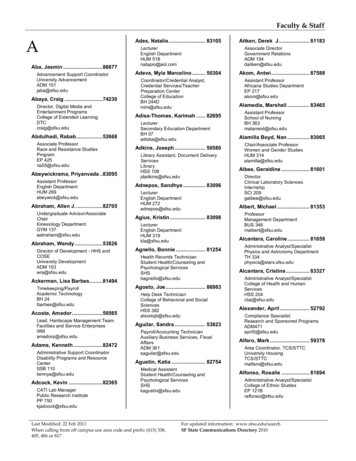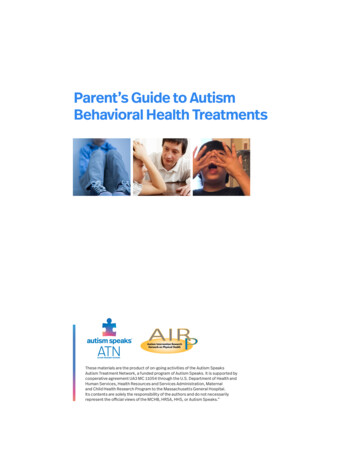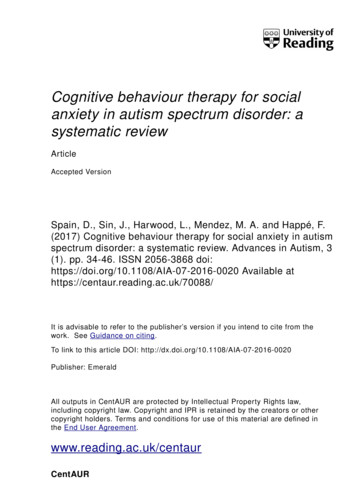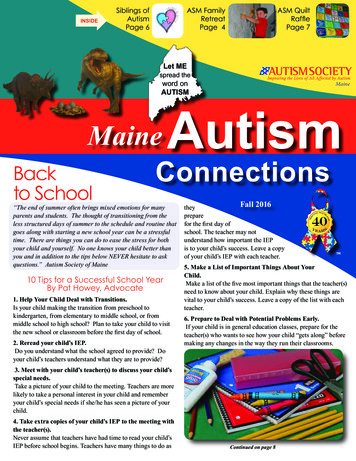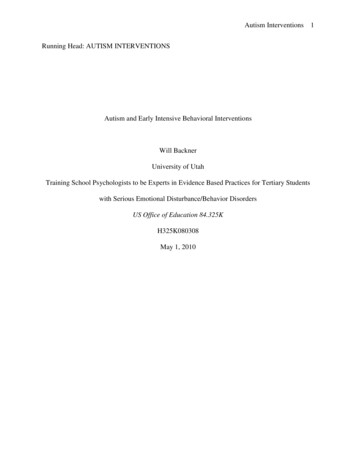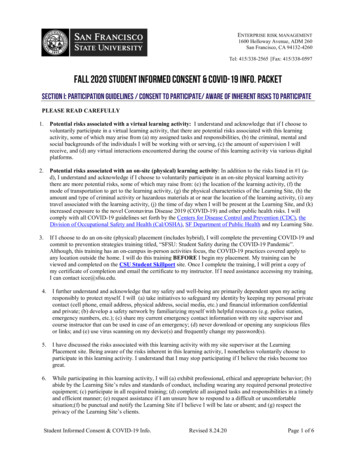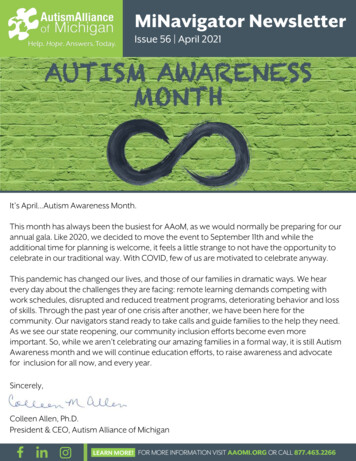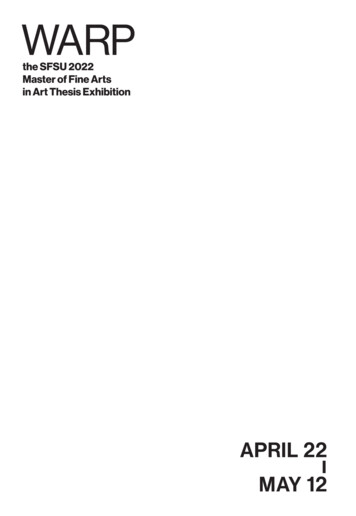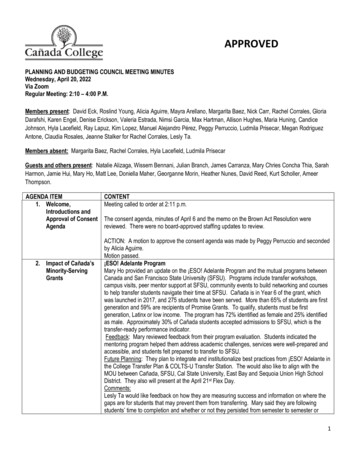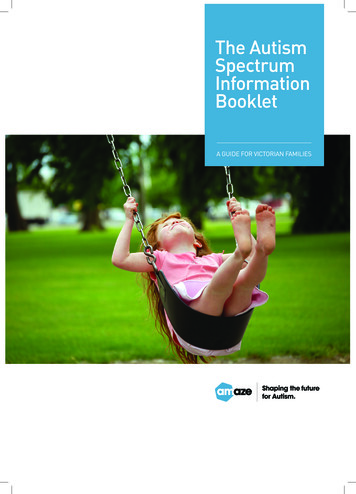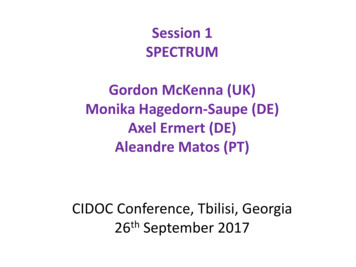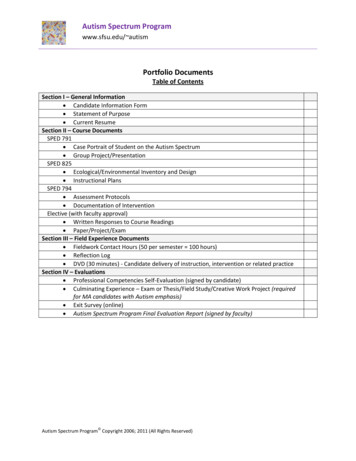
Transcription
Autism Spectrum Programwww.sfsu.edu/ autismPortfolio DocumentsTable of ContentsSection I – General Information Candidate Information Form Statement of Purpose Current ResumeSection II – Course DocumentsSPED 791 Case Portrait of Student on the Autism Spectrum Group Project/PresentationSPED 825 Ecological/Environmental Inventory and Design Instructional PlansSPED 794 Assessment Protocols Documentation of InterventionElective (with faculty approval) Written Responses to Course Readings Paper/Project/ExamSection III – Field Experience Documents Fieldwork Contact Hours (50 per semester 100 hours) Reflection Log DVD (30 minutes) - Candidate delivery of instruction, intervention or related practiceSection IV – Evaluations Professional Competencies Self-Evaluation (signed by candidate) Culminating Experience – Exam or Thesis/Field Study/Creative Work Project (requiredfor MA candidates with Autism emphasis) Exit Survey (online) Autism Spectrum Program Final Evaluation Report (signed by faculty) Autism Spectrum Program Copyright 2006; 2011 (All Rights Reserved)
Autism Spectrum Programwww.sfsu.edu/ autismSection I - General Information Candidate Information Form Statement of Purpose Current Resume Autism Spectrum Program Copyright 2006; 2011 (All Rights Reserved)
Autism Spectrum Programwww.sfsu.edu/ autismCandidate InformationNameStudent ID numberPhone numberPermanent AddressCurrent Address (if different from above)E-mail addressYear Entered Autism Spectrum ProgramYear Completed Autism Spectrum Program Autism Spectrum Program Copyright 2006; 2011 (All Rights Reserved)
Autism Spectrum Programwww.sfsu.edu/ autismStatement of Purpose Autism Spectrum Program Copyright 2006; 2011 (All Rights Reserved)
Autism Spectrum Programwww.sfsu.edu/ autismCurrent Resume Autism Spectrum Program Copyright 2006; 2011 (All Rights Reserved)
Autism Spectrum Programwww.sfsu.edu/ autismSection II – Course DocumentsSPED 791 Case Portrait of Student with ASD Group Project/PresentationSPED 825 Ecological/Environmental Inventory and Design Instructional PlansSPED 794 Assessment Protocols Documentation of InterventionElective (with faculty approval) Written response to course readings Presentation/Project/Exam Autism Spectrum Program Copyright 2006; 2011 (All Rights Reserved)
Autism Spectrum Programwww.sfsu.edu/ autismSection III – Field Experience Documents Fieldwork Contact Hours (50 per semester 100 hours)Reflection LogDVD (30 minutes) Autism Spectrum Program Copyright 2006; 2011 (All Rights Reserved)
Autism Spectrum Programwww.sfsu.edu/ autismFieldwork Contact Hours (Semester 1)Candidate:Semester Month/Year:DATESMonday(hours worked)Field Mentor:Field Sites:Tuesday(hours worked)Wednesday(hours worked)Thursday(hours worked)Friday(hours worked)WEEK 1WEEK 2WEEK 3WEEK 4WEEK 5WEEK 6WEEK 7WEEK 8WEEK 9WEEK 10WEEK 11WEEK 12WEEK 13WEEK 14WEEK 15TOTAL HOURS PER SEMESTER(50 or more hours required) Autism Spectrum Program Copyright 2006; 2011 (All Rights Reserved)HOURS PERWEEK
Autism Spectrum Programwww.sfsu.edu/ autismFieldwork Contact Hours (Semester 2)Candidate:Semester Month/Year:DATESMonday(hours worked)Field Mentor:Field Sites:Tuesday(hours worked)Wednesday(hours worked)Thursday(hours worked)Friday(hours worked)WEEK 1WEEK 2WEEK 3WEEK 4WEEK 5WEEK 6WEEK 7WEEK 8WEEK 9WEEK 10WEEK 11WEEK 12WEEK 13WEEK 14WEEK 15TOTAL HOURS PER SEMESTER(50 or more hours required) Autism Spectrum Program Copyright 2006; 2011 (All Rights Reserved)HOURS PERWEEK
Autism Spectrum Programwww.sfsu.edu/ autismReflection LogEnter weekly reflections of your field experiences with learners on the autism spectrum bynoting impressions, ideas, speculations, feelings, biases and concerns as you apply the practiceslearned in your courses (feel free to create your own template or copy this template).ENTRY DATE:ENTRY DATE: Autism Spectrum Program Copyright 2006; 2011 (All Rights Reserved)
Autism Spectrum Programwww.sfsu.edu/ autismDVD (30 minutes)Record yourself on a DVD for a minimum of 30 minutes while engaged in thedelivery of instruction, intervention or related practices while supporting learnerson the autism spectrum in the field. DVD’s may draw on course assignments inSPED 825, SPED 794 or your elective, as relevant. Autism Spectrum Program Copyright 2006; 2011 (All Rights Reserved)
Autism Spectrum Programwww.sfsu.edu/ autismSection IV – Evaluations Professional Competencies Self-Evaluation (signed by candidate) Culminating Experience – Exam or Thesis/Field Study/Creative Work Project(**required for MA candidates with an emphasis in Autism only) Exit Survey (online) NOTE: link to survey will be provided Autism Spectrum Program Final Evaluation Report (signed by faculty) Autism Spectrum Program Copyright 2006; 2011 (All Rights Reserved)
Autism Spectrum Programwww.sfsu.edu/ autismSelf-EvaluationProfessional Competencies for Autism Related Knowledge and PracticeCandidate Name:Semesters Enrolled (Month/Year):Candidates: Rate at beginning, middle, and end points of participation in Autism Spectrum programRating Scale: 3 highly competent 2 moderately competent 1 emerging competence 0 not yet competentCandidate demonstrates knowledge and skill in:1. Nature of ASD in theory and practice1.1.1.2.1.3.1.4.1.5.1.6.2.Historical and theoretical foundationCurrent definitions (state, federal)Early indicators, etiology, prevalenceDiagnostic tools, criteria (DSM-IV) and differential diagnosisCharacteristics associated with ASDCurrent and emerging practices and service delivery modelsFamily support and partnerships2.1. Supports parents and family members as active participants in all aspects of child’seducation2.2. Responsive to family culture, language, values, parenting styles and personalperspectives2.3. Facilitates communication between school, home and community2.4. Provides family with timely information, education and resources pertinent tochild’s needs2.5. Assists family in accessing community supports and services2.6. Collaborates with family to improve professional practices3.School and community partnerships3.1. Links with community agencies and organizations serving diverse learners withASD across the lifespan3.2. Interdisciplinary team collaboration within and across systems3.3. Accesses community supports and services for children and adults with ASD andtheir families3.4. Facilitates communication between school, home and community4.Individualized educational supports and services4.1. Develops IEP in collaboration with family and professionals across disciplines4.2. Responsive to social, cultural and linguistic backgrounds of each individual andfamily with consideration of family preferences4.3. Degree of structure and level of intensity adapted to child’s strengths, challengesand emergent potentials4.4. Incorporates child’s preferences /special interests in program goals and methods4.5. Incorporates environmental and instructional adaptations and accommodations5.Assessment frameworks and procedures5.1. Typical and atypical learning and development across the lifespan5.2. Formal and informal assessment tools and techniques5.3. Systematically collects and analyzes multiple sources of data across settings toassess and monitor individual learning, development and overall progress5.4. Constructs profiles of strengths, challenges and emergent potential across coredomains of learning and development (Cognition/ learning style;communication/language; social (adults and peers); play and imagination(representational); Behavior patterns (activities, interests); Sensory processing;Adaptive functioning (daily life skills/self-care)5.5. Uses results to set realistic and meaningful goals and plan instruction/ intervention Autism Spectrum Program Copyright 2006; 2011 (All Rights Reserved)BeginningMiddleEnd
Autism Spectrum Programwww.sfsu.edu/ autismRating Scale: 3 highly competent 2 moderately competent 1 emerging competence 0 not yet competent6.Curriculum and instruction6.1. Balanced functional, developmental and academic curriculum aligned withCalifornia Learning Standards (http://www.cde.ca.gov/standards).and addressesCross-cultural Language and Academic Development (CLAD) for English languagelearners6.2. Well planned, systematic and differentiated instruction adapted to range of ages,abilities, interests and learning styles6.3. Instructional activities provide multiple opportunities to practice skills acrossnatural learning contexts within home, school and community6.4. Varied instructional formats through multiple modes of one-to-one, small group,large-group, adult-directed, child-centered, and peer mediated instruction gearedto individual6.5. Supports maintenance of learned skills over time and generalization of skills tonatural settings6.6. Trains and manages para-educators/program staff7.Structuring the learning environment7.1.7.2.7.3.7.4.7.5.7.6.8.Clearly organized and comprehensible learning environmentsUse of visual cues and supports to maximize engagement and learningIncorporates predictable routines, rituals, schedules for activities and eventsStructures materials and work tasksDefines physical space with clear boundariesFacilitates transitions, flexibility and changeAddressing challenging behaviors8.1. Functional approach through Positive Behavior Supports8.2. Responsive to unique modes of communication, social-emotional regulation andsensory processing8.3. Data-based functional behavioral assessments (FBA) and behavior supports plansconsistent with state and federal guidelines8.4. Application of a variety of empirically validated behavioral intervention strategies(ABA, cognitive behavior)8.5. Crisis intervention techniques9.Supporting communicative competence9.1. Patterns of speech, language and communication in ASD9.2. Continuum of approaches to assessment and intervention (discrete trial,traditional behavioral, developmental, social-pragmatic)9.3. Supports intentional and spontaneous communication across partners, activitiesand settings9.4. Functional expressive and receptive communication for mute, pre-verbal andverbal children9.5. Augmentative and alternative communication (AAC) strategies9.6. Integrating verbal and nonverbal forms of communication10. Supporting social competence10.1. Patterns of socialization with adults and peers in ASD10.2. Supports spontaneous joint attention, imitation, initiations and social reciprocityacross partners, activities and setting10.3. Adult-directed social skills training (ABA/direct instruction)10.4. Child-centered approaches (developmental, relationship-based, transactional)10.5. Peer-mediated practices10.6. Social-cognitive approaches Autism Spectrum Program Copyright 2006; 2011 (All Rights Reserved)BeginningMiddleEnd
Autism Spectrum Programwww.sfsu.edu/ autismRating Scale: 3 highly competent 2 moderately competent 1 emerging competence 0 not yet competent11. Supporting play/leisure and imagination11.1. Patterns of play and imagination in ASD11.2. Supports spontaneous engagement in a range of developmentally and ageappropriate play/leisure activities across independent and social contexts11.3. Incorporating play materials, activities and themes varying in degree of symbolicrepresentation11.4. Adult-directed approaches11.5. Child-centered approaches11.6. Peer-mediated approaches12. Inclusion with typical peers12.1. Facilitates inclusion across natural contexts within school, home and communitysettings12.2. Explicit guidance for both children with autism and typical peers12.3. Creates culture of inclusion via awareness activities that promote understanding,empathy and acceptance of diverse learners with ASD12.4. Consistent opportunities to form social relationships and mutual friendships12.5. Guided participation in mutually enjoyed activities that are a natural part of thepeer culture (play and recreation)12.6. Designs inviting play spaces and selects play materials with high interactivepotential13. Transition, vocational and independent living13.1. Promotes adaptive behaviors to foster independence at all age and ability levels13.2. Plans transitions from one classroom, program or service delivery system toanother13.3. Supports transition to self-determined careers and post-secondary education andcommunity living13.4. Training in vocational and independent living skills13.5. Interagency collaboration13.6. Self-advocacy and disclosure perspectives of adults with ASD14. Professional literacy and leadership14.1.14.2.14.3.14.4.14.5.14.6.Peer reviewed journals and publications on research and practice in ASDProfessional and parent organizations (local, national and international)Current trends and controversies in the field of ASDJudges quality and efficacy of educational program models, services and practicesEngages in reflective practice via multiple modes of field-based systematic inquiryUses multi-media technology to produce and present educational tools andtechniques Autism Spectrum Program Copyright 2006; 2011 (All Rights Reserved)BeginningMiddleEnd
Autism Spectrum Programwww.sfsu.edu/ autismCulminating ExperienceEvidence of passing grade on Comprehensive Written Exam (Autism Focus) orThesis/Field Study/Creative Work Project**Required for Master of Arts candidates with an emphasis in Autism only Autism Spectrum Program Copyright 2006; 2011 (All Rights Reserved)
Autism Spectrum Programwww.sfsu.edu/ autismFinal Evaluation Report FormCandidate Name:Date of ReportThis candidate has successfully completed the following (check response):Professional Portfolio Documents and ArtifactsYesNoSection I – General Information Candidate Information Form Statement of Purpose Current ResumeSection II – Course DocumentsSPED 791 Case Portrait of Student on the Autism Spectrum Group Project/PresentationSPED 825 Ecological/Environmental Inventory and Adaptation Instructional plan paper*SPED 794 Assessment Protocols Intervention paper*Elective Adult interview summary Related course paper/project or examSection III – Field Experience Documents Fieldwork Contact Hours (100 hours) Weekly reflection log DVD (30 minutes) Candidate delivery of instruction, intervention orrelated practice *Section IV – Evaluations Self-Evaluation (signed by candidate) Culminating Experience – Exam or Thesis/Field Study/Creative WorkProject (required for MA candidates with Autism emphasis) Exit Survey (online)Autism Spectrum Program Final EvaluationYesNoDemonstrated professional competencies in autism related knowledge and skilland therefore, has fulfilled the requirements of the Autism Spectrum graduatecertificate program at SFSUIf candidate was not successful in all areas listed above, please describe the situation and action to betaken.Additional comments concerning the candidate’s performance.Signature of Supervising Faculty Autism Spectrum Program Copyright 2006; 2011 (All Rights Reserved)
Autism Spectrum Program www.sfsu.edu/ autism Autism Spectrum Program Copyright 2006; 2011 (All Rights Reserved) Self-Evaluation Professional Competencies for Autism .
